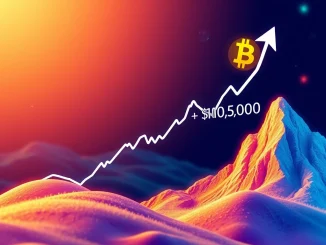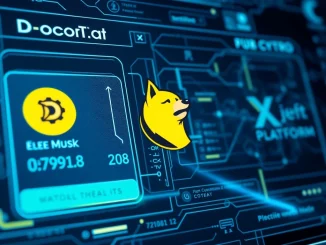
In the volatile world of cryptocurrencies, where market sentiment can shift in an instant, a recent event involving the STRIKE token has sent ripples of surprise through the community. Imagine a digital asset, explicitly marked for delisting from major exchanges, not crashing but instead embarking on an astonishing upward trajectory. This isn’t a hypothetical scenario; it’s precisely what unfolded with STRIKE on South Korean platforms like Upbit, challenging conventional wisdom and sparking intense debate among traders and analysts alike. How could a token facing what’s usually considered a death knell suddenly become a star performer?
The STRIKE Token’s Astonishing Ascent Amidst Delisting Fears
The crypto market is no stranger to dramatic price movements, but the recent performance of the STRIKE token stands out as particularly perplexing. Following a stark delisting notice from prominent South Korean exchanges, including Upbit and Bithumb, one might expect a sharp decline, perhaps even a freefall. Yet, STRIKE defied all expectations, experiencing an extraordinary surge that left many scratching their heads.
Let’s break down the timeline and numbers:
- Delisting Notice: On July 21, at 09:20 UTC, Upbit announced its decision to delist STRIKE. Typically, this news triggers a sell-off as investors rush to exit positions before liquidity dries up.
- Initial Dip: Immediately following the announcement, STRIKE’s price on Upbit dipped to a low of approximately 7,600 won (roughly $5.52). This initial reaction was in line with conventional market behavior.
- The Rebound: What happened next was anything but conventional. Over the next two days, the token staged a remarkable comeback. By July 23, STRIKE had soared to 29,590 won ($21.47) on Upbit.
- The Surge: This rebound represents a staggering 289% increase from its lowest point post-notice. At the time of this publication, STRIKE maintains a strong position, trading around 26,300 won ($19.09) on Upbit, reflecting a daily gain of 44%.
This dramatic reversal begs the question: What forces were at play to propel a seemingly doomed asset to such heights?
Unpacking the Upbit Delisting Notice: A Paradox?
A Upbit delisting notice typically signals the imminent end of a token’s trading life on an exchange. Exchanges issue such notices for a variety of reasons, which can range from low trading volume and liquidity concerns to security vulnerabilities, regulatory non-compliance, or the project’s failure to meet ongoing listing standards. For investors, it usually means a scramble to sell their holdings or transfer them to a wallet or another exchange before trading ceases, often leading to a rapid price collapse.
So, why did STRIKE react so differently? This unusual behavior has led many to speculate about the ‘delisting pump’ phenomenon. In rare instances, tokens facing delisting can experience a short-term price surge. This might occur due to a confluence of factors, creating a unique market dynamic:
Possible Drivers Behind the Delisting Pump:
- Short Squeeze Potential: Traders betting against the token (shorting it) might be forced to cover their positions as the price unexpectedly rises, fueling further upward momentum.
- Liquidation Demand: Users who held the token on the exchange might need to acquire more to meet minimum withdrawal thresholds or to settle outstanding positions, creating a temporary surge in buy orders.
- Speculative Trading Frenzy: A belief among a segment of traders that the token might relist elsewhere, or that there’s a final, high-risk opportunity for quick profits before liquidity completely dries up. This often attracts daring, short-term speculators.
- Market Manipulation: While unconfirmed, large holders or groups could potentially coordinate buying efforts to create artificial demand, exploiting the impending delisting for a final profit before exiting.
Understanding these underlying mechanisms is crucial to grasping the paradox of STRIKE’s surge.
Why Did This Crypto Price Surge Happen Specifically in South Korea?
The unique characteristics of the South Korea crypto market often play a significant role in such anomalous price movements. South Korea boasts a highly active and passionate retail investor base, often influencing global crypto trends. This demographic is known for its quick reactions, high trading volumes, and willingness to engage in high-risk, high-reward trading, sometimes leading to phenomena like the ‘Kimchi Premium’ (where crypto assets trade at a higher price in South Korea compared to global markets).
Several factors specific to the South Korean market could have contributed to STRIKE’s unusual surge:
- FOMO (Fear of Missing Out): As the price began its initial uptick, the highly interconnected and responsive South Korean retail investor community, ever-alert to rapid gains, might have piled in en masse. This collective buying pressure, fueled by FOMO, can create a powerful self-fulfilling prophecy in illiquid markets.
- Concentrated Liquidity: With Upbit being one of the primary exchanges for STRIKE in South Korea, the delisting notice effectively concentrated remaining liquidity. Any significant buy orders would have a disproportionate impact on the price due to reduced supply.
- Cultural Trading Patterns: Anecdotal evidence suggests that some South Korean traders are more inclined to engage in high-risk plays, viewing delisting announcements as potential “last chance” opportunities for quick profits, rather than immediate exits.
- Information Dissemination: The speed at which information and trading narratives spread within local online communities can rapidly mobilize a large number of retail traders, leading to synchronized buying activity.
This regional specificity highlights how local market dynamics can diverge significantly from global trends, presenting both unique opportunities and heightened risks.
Navigating the Perilous “Delisting Pump” Phenomenon
The remarkable delisting pump of the STRIKE token serves as a potent reminder of the inherent risks and potential, albeit fleeting, rewards in crypto trading. While the immediate gains for early participants were substantial, such events are often short-lived and extremely volatile. For every investor who profited, there are likely many who will be caught off guard, facing significant losses as liquidity rapidly diminishes and the token’s value collapses post-delisting.
Key Considerations for Investors:
- Extreme Volatility: Prices can swing wildly in minutes, making entry and exit points incredibly difficult to predict. What goes up dramatically can come down even faster.
- Liquidity Drain: Post-delisting, the token often becomes illiquid, meaning there are few buyers and sellers. This can make it impossible to sell your holdings, trapping your capital.
- Regulatory Scrutiny: Such anomalous price movements, especially around delisting events, can attract the attention of regulators, potentially leading to investigations.
- Information Asymmetry: The most profitable trades in these scenarios are often made by those with insider knowledge or superior access to market data, leaving retail investors at a disadvantage.
This phenomenon is a high-stakes gamble, not a reliable investment strategy. It preys on FOMO and the desire for quick riches, often leading to painful lessons for those who aren’t extremely cautious and quick.
Lessons for the Savvy Crypto Investor
The STRIKE token saga offers valuable insights for anyone navigating the unpredictable crypto landscape. It underscores several crucial principles:
- Do Your Own Research (DYOR): Always understand the fundamentals of a project, its utility, and its market position, rather than solely relying on price action.
- Beware of FOMO: The fear of missing out can lead to irrational decisions. Always maintain a clear head and stick to your trading plan.
- Risk Management is Key: Never invest more than you can afford to lose, especially in highly volatile assets or during unusual market events like a delisting pump. Consider setting stop-loss orders.
- Understand Exchange Policies: Be aware of the delisting policies of the exchanges you use and monitor announcements closely.
- Liquidity Matters: High liquidity allows for easy entry and exit. Illiquid markets, especially those affected by delisting, pose significant risks.
The STRIKE token’s journey from delisting notice to extraordinary surge on Upbit is a captivating, albeit cautionary, tale in the annals of cryptocurrency. It powerfully illustrates the unique blend of market psychology, regional trading quirks, and inherent volatility that defines this nascent asset class. While such ‘delisting pumps’ can be tempting for their rapid, almost unbelievable gains, they are fraught with extreme risk and are rarely sustainable. This event serves as a crucial reminder for all investors to exercise extreme caution, conduct thorough due diligence, and never invest based solely on speculative surges. The crypto market offers immense opportunities, but true success lies in informed decisions, robust risk management, and a healthy skepticism towards events that defy logical market behavior.
Frequently Asked Questions (FAQs)
1. What is a crypto delisting notice?
A crypto delisting notice is an official announcement from a cryptocurrency exchange stating that a specific digital asset will be removed from its trading platform. This means users will no longer be able to buy or sell that token on the exchange after a specified date. Reasons for delisting can include low trading volume, project inactivity, regulatory non-compliance, or security issues.
2. Why did the STRIKE token pump instead of dump after the delisting notice?
While counter-intuitive, the STRIKE token experienced a ‘delisting pump’ due to a combination of factors: potential short squeezes, temporary demand for withdrawals, speculative trading by risk-tolerant investors seeking quick profits, and possibly market manipulation. The unique, highly reactive retail investor base in South Korea also played a significant role in amplifying this effect.
3. Is it safe to trade tokens facing delisting?
Trading tokens facing delisting is extremely risky and generally not recommended for most investors. While some traders might profit from a ‘delisting pump,’ these events are characterized by extreme volatility, low liquidity, and a high probability of rapid price collapse once the delisting date approaches or passes. The risk of losing your entire investment is substantial.
4. What is the ‘Kimchi Premium’ in South Korea’s crypto market?
The ‘Kimchi Premium’ refers to a phenomenon where cryptocurrency assets trade at a higher price on South Korean exchanges compared to their prices on global exchanges. This premium is often attributed to strong retail demand, capital controls, and limited arbitrage opportunities, contributing to unique market dynamics within South Korea.
5. What are the main risks associated with a ‘delisting pump’?
The main risks include extreme price volatility, leading to rapid and unpredictable gains or losses; severe liquidity drain, making it difficult or impossible to sell your tokens; and the high likelihood of the token’s value plummeting to near zero once trading officially ceases or the speculative frenzy ends. It’s a high-risk, high-reward scenario where losses are often permanent.



